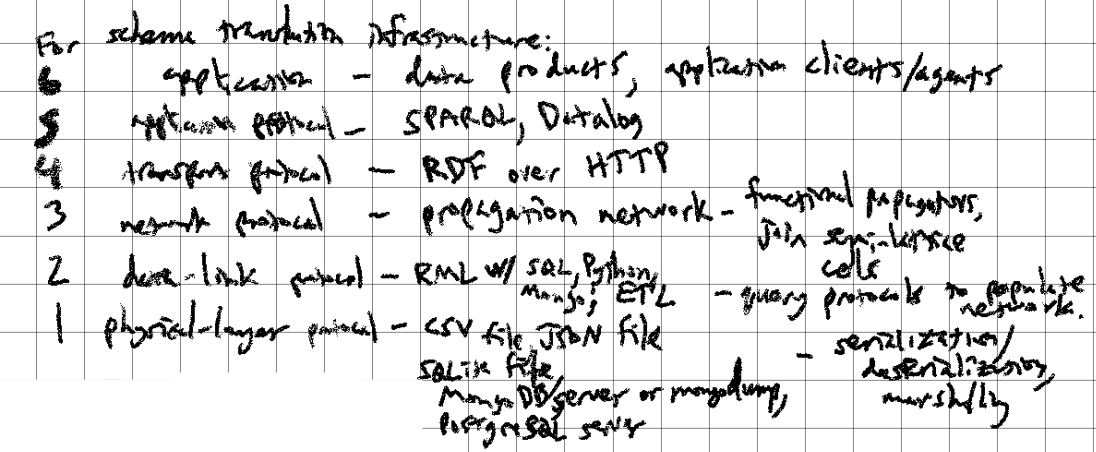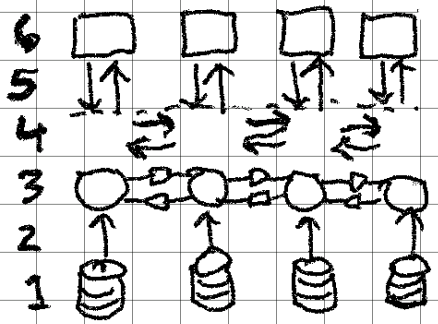Schema Translation Infrastructure
Repurposing data is hard sometimes. Given a current application’s data-worldview – i.e., its schema – one cannot in general pull in historical data collected for different applications because those applications had different worldviews – i.e., they used different data schemas.
One may perform one-off or ongoing transformations – e.g. ETL jobs – as part of a hub-and-spoke strategy to bring data from past worlds into the “present” world so that all the data can be queried in a uniform way, in the language of the present-application schema.
Unfortunately, the “present” world is a moving target. And “past” worlds may be merely dormant – they may become “present” again if a given application is revisited.
Rather than hub-and-spoke schema convergence and single-timeline data migration, what if schema translation infrastructure sought to reconcile queries across multiple worlds? That is, what if application-X-centric questions could travel to and collect partial information from other-application-centric worlds using the languages (schema) of those worlds?
Building off Ink & Switch’s ideas on edit lenses for schema evolution1 and off Radul and Sussman’s ideas on propagation networks for computation2, as well as off the observed salubrious hourglassing of the Internet’s layered-architecture design3, I’m thinking about how to facilitate effective “schema networking” that acknowledges and embraces the never-ending schema evolution characteristic of data collection efforts by research-producing organizations.
Initial Scribbles
First, I offer a simplified recapitulation of the layered architecture of the Internet:

Layered Architecture for the Internet
Next, I offer a mapping of the above to an analogous six-layered architecture for schema translation:

Layered Architecture for Schema Translation
The physical protocol layer is concerned with data (de)serialization/marshalling and storage. The data-link protocol layer is where ETL happens – how bytes are de-isolated and made accessible to the network. The network protocol layer is where propagation among worldviews/schemas “runs”, with each “cell” (in the parlance of the propagation network literature) a join-semilattice (or is it a meet-semilattice?) world that accumulates partial information via edit-lens functional propagators. The transport protocol layer is RDF over HTTP (FAIR Digital Objects?), the application protocol layer is RDF query (SPARQL, a Datalog, etc.), and the application layer is where specific-worldview-conforming data (i.e., things you plot, perform exploratory data analysis (EDA) on, select/engineer features from to feed to ML-model training, etc.) materialize.
Finally, I offer a rough diagram of how various layer activities and dataflow within/between them may be visualized:

Schema Translation Infrastructure in Action
I want to close by noting that the problem of schema reconnection comes up not only with research laboratory datasets that were collected independently by different teams, but also with datasets collected over a long period of time by a single team as project/application requirements evolve and place adaptation pressure on the “working” schema to undergo several revisions, thus necessitating reconnection among schema versions (i.e. migrations, but not necessarily unidirectional if, say, a sub-team is still using an “old” schema and wants to contribute “new” data).
References
“Project Cambria: Translate your data with lenses,” Oct. 06 , 2020. https://www.inkandswitch.com/cambria/ (accessed Aug. 01, 2022). ↩︎
A. Radul, “Propagation networks: a flexible and expressive substrate for computation,” Thesis, Massachusetts Institute of Technology, 2009. Accessed: Aug. 11, 2022. [Online]. Available: https://dspace.mit.edu/handle/1721.1/54635 ↩︎
Beck, M. (2019). On the hourglass model. Communications of the ACM, 62(7), 48–57. https://doi.org/10/gj3fnj ↩︎